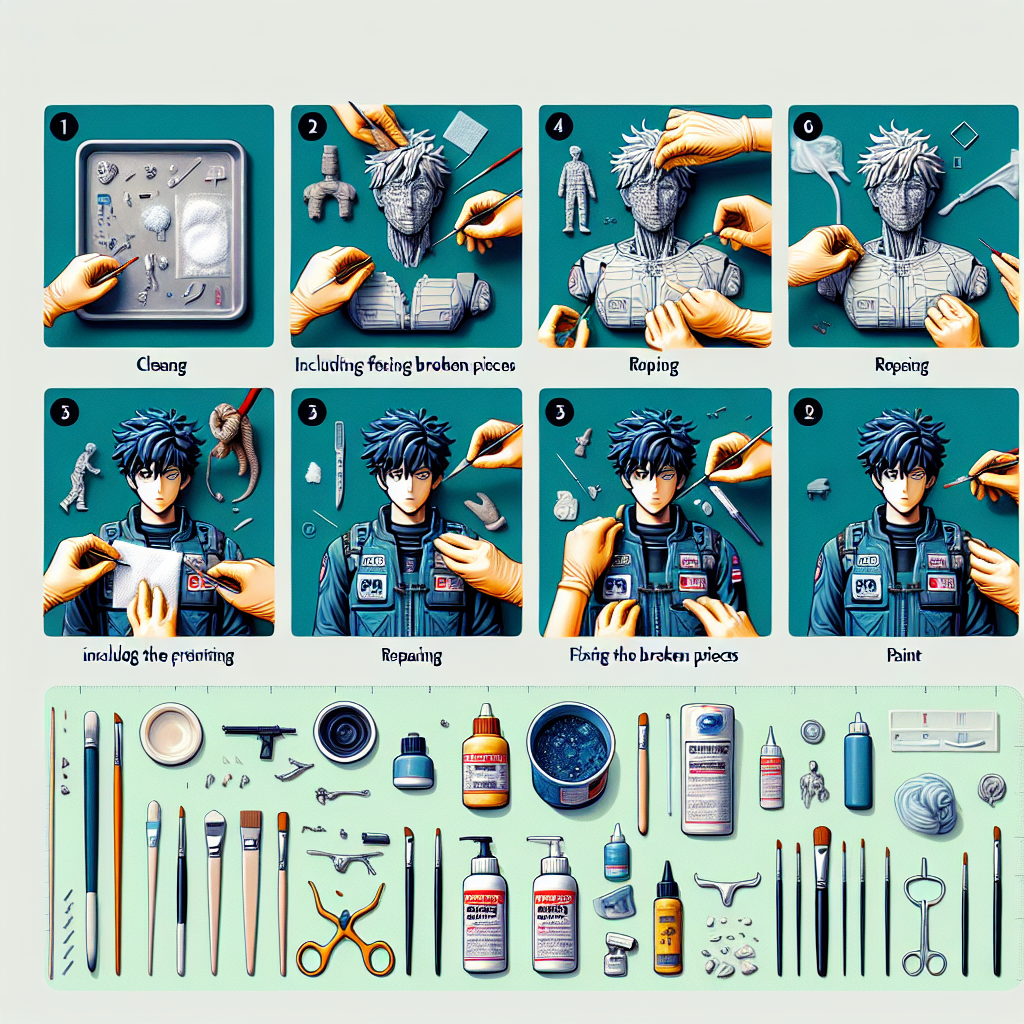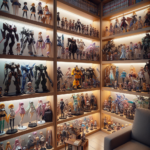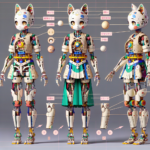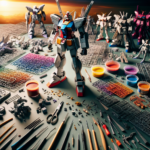
Unlock the Secrets to Repairing Your Life-Size Anime Figure
Every anime collector knows the heartache of discovering a scratch or a crack on their prized life-size figure. But don’t let damage keep your favorite characters from looking their best. With the right knowledge and tools, you can bring your figures back to their former glory. Let’s get started on the path to restoration!
Typical Damages and Wear
Life-size anime figures can suffer from a range of issues. Whether it’s a faded paint job, a broken limb, or even just the accumulation of dust, each problem has a solution. Let’s look at what you might encounter:
- Scratches that mar the figure’s surface
- Cracks from accidental drops or temperature changes
- Chipped paint that diminishes the figure’s vibrant look
- Loose or broken joints that affect the figure’s pose
- Sticky residue from environmental factors or aging materials
Essential Tools for Restoration
Before diving into the repair work, it’s important to have the right tools on hand. These essentials will help you tackle most issues you’ll come across:
- High-quality model paint and brushes
- Fine-grit sandpaper for smoothing surfaces
- Super glue or plastic cement for mending breaks
- Cotton swabs and soft cloths for cleaning and polishing
- Protective gloves to keep oils from your hands off the figure
Initial Steps for Figure Assessment
Before you start the actual repair, it’s crucial to thoroughly assess your figure. This step ensures you understand the full extent of the damage and plan your restoration accordingly.
Identifying the Extent of Damage
Take a close look at your figure from all angles. Note any areas of concern, from the smallest scratch to larger structural issues. Documenting these with photos can be helpful as you move forward with repairs.
Preparing Your Workspace
A clean, well-lit workspace is key to a successful restoration. Gather all your tools and materials, and make sure you have plenty of room to work. A magnifying lamp can be a lifesaver when dealing with fine details.
- Clear a large table or desk for your work area
- Ensure good lighting, possibly with a task lamp
- Lay down a protective mat or cloth to catch spills
- Keep your tools organized and within reach
Restoration Techniques for Common Issues
Now that you’re prepared, let’s tackle the most common issues you’ll face with your life-size anime figure. Each problem has a technique to fix it, and I’ll guide you through them step by step.
Remember, patience is your best friend during this process. Take your time with each repair, and your figure will thank you with a look that’s as stunning as the day you first displayed it.
Fixing Scratches and Surface Scuffs
Scratches can seem like a nightmare, but they’re often the easiest issue to fix. Start with a fine-grit sandpaper and gently buff the scratched area. The goal is to smooth out the damage without affecting the surrounding area. Once you’re done sanding, wipe the area with a slightly damp cloth to remove any dust.
Mending Broken Pieces and Cracks
For breaks and cracks, super glue or plastic cement is your best friend. Apply a small amount to one side of the broken piece, press firmly together, and hold. Give it ample time to dry before you move on. If there’s a gap, you can fill it in with putty, then sand it down once it’s set.
Addressing Paint Chips and Fading
Paint chips and fading can take away from the vibrant look of your figure. To touch up the paint, use a small brush and carefully apply model paint that matches the original color. For fading, you might need to repaint larger sections or even the entire figure to ensure a uniform look.
Solving the Stickiness Dilemma
Stickiness often results from a breakdown of the materials used in the figure. To tackle this, mix a solution of warm water and mild detergent. Use a soft cloth to gently clean the sticky areas. If the stickiness persists, you may need to use a specialized plastic cleaner.
Repainting Your Anime Figure Like a Pro
Repainting your figure can be daunting, but it’s a great way to breathe new life into it. Whether you’re doing small touch-ups or a complete overhaul, the right techniques will make a world of difference.
Choosing the Right Type of Paint
Always opt for high-quality model paints designed for plastic. These paints adhere better and offer a finish that matches the original look of your figure. Acrylic paints are a popular choice because they’re easy to work with and quick to dry.
Color Matching Techniques
Getting the perfect color match is crucial. You can mix paints to get the right shade, or use a color wheel to help you find complementary colors. Take your time with this step – the closer the match, the better the final result will be.
Applying Paint for Smooth Finish
When it comes to repainting, achieving a smooth finish is the goal. After choosing the right paint and color matching, it’s time to apply it. Use a fine brush for detailed areas and a broader brush for larger sections. Apply thin layers, allowing each to dry before adding the next. This technique prevents the paint from running or clumping, ensuring a professional-looking finish.
Long-Term Care and Preventative Measures
Restoration is just the beginning. To keep your anime figures looking impeccable, long-term care and preventative measures are key. These steps will help you maintain the pristine condition of your figures for years to come.
Reducing Handling to Preserve Detail
Handling your figures can lead to accidental damage and wear. To preserve the intricate details, handle them as little as possible and always with clean, dry hands. When you do need to move your figure, do so gently, supporting the base and the main body.
Effective Dusting without Damage
Dust can accumulate quickly and detract from the beauty of your figures. To dust effectively, use a soft, microfiber cloth or a gentle brush. Lightly sweep over the surface without applying too much pressure. This will keep your figures dust-free and prevent any scratches or damage during cleaning.
Optimal Display and Storage to Avoid Future Harm
- Display cases with UV protection to prevent fading from sunlight
- Climate-controlled environments to avoid temperature-related damage
- Shelves with guardrails to prevent falls
- Avoiding areas with high foot traffic to reduce the risk of accidents
- Using acrylic risers to elevate figures and protect them from spills
Advanced Cleaning and Maintenance Methods
Beyond the basics, there are advanced cleaning and maintenance methods that can help you tackle more persistent issues. These techniques require a bit more effort but can significantly improve the appearance and longevity of your figures.
Deep Cleaning Process for Sticky Residue
Sticky residue can be stubborn, but a deep cleaning process can help. Start by using a plastic-safe cleaner and a soft cloth. Gently rub the area in a circular motion. If the residue remains, consider using a diluted solution of isopropyl alcohol. Apply it sparingly with a cotton swab, being careful not to damage the paint or finish.
Remember, the key to a successful restoration and long-term care of your life-size anime figures is patience and attention to detail. By following these guidelines, you can ensure that your figures remain as stunning and impressive as the day you brought them home.
Regular Touch-Ups and Checkups
To maintain the pristine condition of your anime figures, incorporate regular touch-ups and checkups into your routine. Inspect your figures periodically for any signs of wear or damage. Quick action on small issues can prevent them from becoming major problems. A dab of paint here, a gentle cleaning there, and your figures will continue to shine as centerpieces of your collection.
Giving Your Figures a New Lease on Life
Restoration isn’t just about repairs; it’s about revitalizing your figures to their best state. With each careful touch-up, each detailed cleaning, you’re not only preserving what’s there, you’re enhancing the figure’s presence in your collection. Your dedication will breathe new life into every character, making them ready for many more years of admiration.
Reviving Color and Luster
Over time, figures can lose their vibrant colors and shine. To bring back that new-figure luster, use specialized polishes designed for collectibles. Apply these products sparingly and buff gently with a soft cloth. The right product can make colors pop and surfaces gleam, just like they did when you first fell in love with them.
Ensuring Structural Stability
Keeping your figures structurally sound is crucial. Check the joints and support structures for any signs of weakness. If you find any, reinforce them with the appropriate adhesives or internal supports. A stable figure is not only more visually appealing but also safer to display and less prone to future damage.
Key Takeaways: Article-at-a-Glance
- Regular maintenance is key to preserving the beauty of your figures.
- Addressing small issues promptly can prevent larger problems.
- Restoration enhances both the appearance and the lifespan of your figures.
- Using the right products can revive the color and luster of your figures.
- Ensuring structural stability is essential for safe display and longevity.
Frequently Asked Questions (FAQ)
How often should I clean my life-size anime figure?
It’s best to lightly dust your figures at least once a week to prevent buildup. For a more thorough cleaning, every few months should suffice, depending on the environment they’re displayed in. If your figures are in a case or a controlled setting, you might be able to extend the time between deep cleanings. Always keep an eye out for dust and address any spills or stains immediately to keep your figures in top condition.
Can I repair a broken life-size anime figure myself?
Yes, you can often repair a broken life-size anime figure on your own. With patience and the right tools, such as super glue or plastic cement for bonding and putty for filling gaps, you can fix many common issues. However, if the damage is extensive or if the figure is very valuable, consider consulting a professional restorer to ensure the best results.
- Assess the damage carefully before attempting a repair.
- Use the right adhesive for the material of your figure.
- Clamp or hold the pieces together securely as the glue dries.
- Be prepared to paint over the repair site to conceal your work.
What kind of paint should I use for touch-ups?
For touch-ups, acrylic model paint is the best choice. It’s versatile, dries quickly, and comes in a wide range of colors. Make sure to select a paint that is compatible with the material of your figure. If you’re unsure, test the paint on a small, inconspicuous area first to ensure it adheres well and looks right.
How can I prevent my anime figure from becoming sticky?
To prevent your anime figure from becoming sticky, avoid exposing it to direct sunlight, high temperatures, and humidity, as these can break down the materials over time. Regular cleaning with a mild soap and water solution can also help remove any residue before it becomes a problem. If your figure has a protective coating, make sure to maintain it according to the manufacturer’s instructions.
- Use display cases with UV protection to shield from sunlight.
- Keep your figures away from vents or windows to avoid temperature fluctuations.
- Position your figures out of high traffic areas to prevent accidental bumps or falls.
- Secure your figures on sturdy shelves or bases to minimize the risk of tipping over.
In conclusion, restoring and maintaining your life-size anime figure can be a rewarding process that not only preserves but also enhances the beauty and longevity of your collection. By understanding the common issues and how to address them, choosing the right tools and materials for repairs, and following best practices for display and storage, you can ensure that your figures remain in pristine condition for years to come. Remember, the key to successful restoration is patience, attention to detail, and a gentle touch. With these guidelines in hand, you’re well-equipped to tackle any challenges that come your way and keep your beloved characters looking their absolute best.




